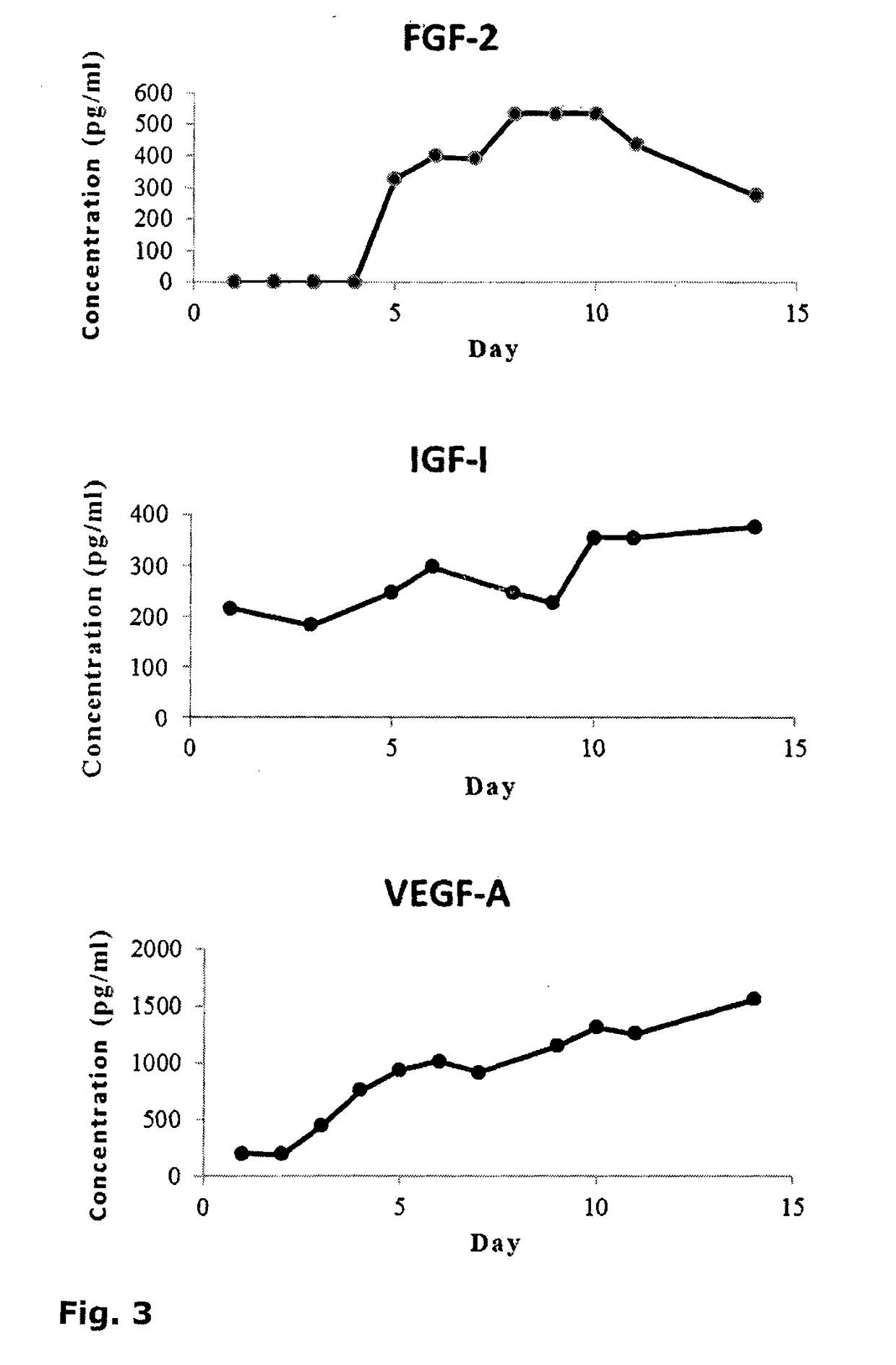Cell-Based Device For Local Treatment With Therapeutic Protein
a technology of local treatment and cell-based devices, which is applied in the direction of pharmaceutical delivery mechanisms, peptide/protein ingredients, surgery, etc., can solve the problems of inability to improve patient medical condition, high preparation costs, and inability to successfully conduct clinical trials of factors, so as to reduce the possibility of adverse side effects, and facilitate the modification of the combination
- Summary
- Abstract
- Description
- Claims
- Application Information
AI Technical Summary
Benefits of technology
Problems solved by technology
Method used
Image
Examples
example 1
Preparation of DNA Constructs
[0101]DNA sequences for therapeutic proteins described above were either ordered from supplier, e.g. “Sino biological Inc.”, or designed from amino-acid sequences of the selected protein domains using tool Designer from DNA2.0 Inc. that enables the user to design DNA fragments and optimize expression for the desired hosts (e.g. human cells) using codon optimization. DNA encoding the genes were then ordered from GeneArt or GeneScript, cut out with restriction endonucleases (restriction enzymes) and cloned into the appropriate vector containing necessary regulatory sequences known to the experts in the field. Vectors used include commercial vectors of pcDNA, pMXs etc. carrying all necessary features such as antibiotic resistance, origin of replication and multiple cloning site.
[0102]Molecular biology methods (DNA fragmentation with restriction endonucleases, DNA amplification using polymerase chain reaction-PCR, PCR ligation, DNA concentration detection, a...
example 2
Preparation of Transient and Stable Cell Lines
[0103]Selected carrier cell lines HEK293 (ATCC CRL-1573), NIH 3T3 (ATCC CRL-1573) and ARPE-19 were transfected with prepared constructs for the constitutive production of therapeutic proteins via lipofectamine 2000 and polyethylene imine reagents. 24 h to 36 h post transfection the production of therapeutic proteins was assessed in cell culture supernatant by commercially available ELISA tests.
[0104]Therapeutic cell lines were generated by the addition of selective marker (antibiotic such as neomycin, puromycin, zeocin or blasticidine). Several clones exhibiting high therapeutic protein secretion level, growth characteristics and stability were selected for each therapeutic protein. Stocks of therapeutic cell lines were frozen and stored in liquid nitrogen vapor phase.
[0105]Mouse fibroblasts NIH 3T3 were plated at low density in 10 cm petri dish and transfected with plasmids encoding soluble factors (EGFL7, FGF-2, IGF-I, PDGF-B, TGF-β1 a...
example 3
Gap Migration Assay of Therapeutic Protein Combinations
[0107]The effect of each therapeutic protein and their combinations was first tested in gap migration assay on established cell line NIH 3T3.
[0108]One day before the wound scratch assay, NIH 3T3 cells (5*104 cells / well) were seeded onto 8 well μ-slide with inserted culture insert (Ibidi). Day after seeding a confluent monolayer of cells was formed. Insert was removed leaving a 500 μm gap. Supernatants containing a single therapeutic protein or a combination in concentrations ranging from 1 pg / ml to several ng / ml were added. Gap closure was measured after 6, 12 and 24 h. As seen in FIG. 1, the addition of therapeutic proteins had a positive effect on wound closure compared to control without growth factors. Addition of a combination of 6 growth factors (EGFL7, FGF-2, IGF-I, PDGF-B, TGF-β1 and VEGF-A) had the best effect on gap closure.
PUM
| Property | Measurement | Unit |
|---|---|---|
| concentration | aaaaa | aaaaa |
| concentration | aaaaa | aaaaa |
| concentration | aaaaa | aaaaa |
Abstract
Description
Claims
Application Information
 Login to View More
Login to View More - R&D
- Intellectual Property
- Life Sciences
- Materials
- Tech Scout
- Unparalleled Data Quality
- Higher Quality Content
- 60% Fewer Hallucinations
Browse by: Latest US Patents, China's latest patents, Technical Efficacy Thesaurus, Application Domain, Technology Topic, Popular Technical Reports.
© 2025 PatSnap. All rights reserved.Legal|Privacy policy|Modern Slavery Act Transparency Statement|Sitemap|About US| Contact US: help@patsnap.com



